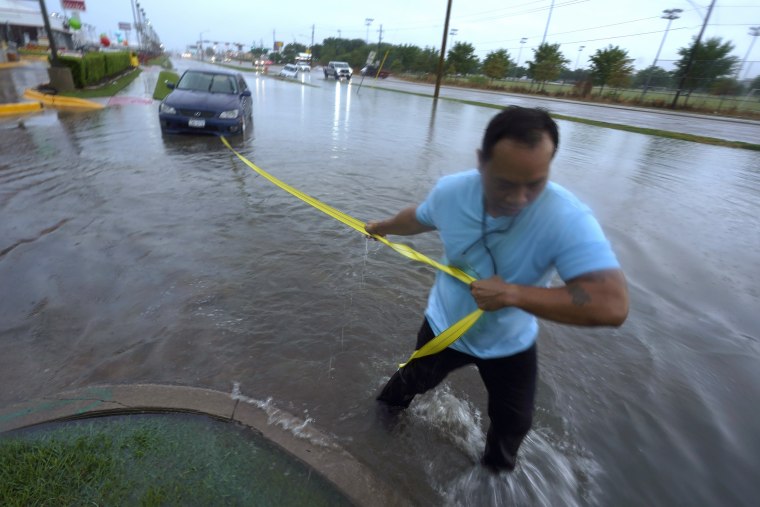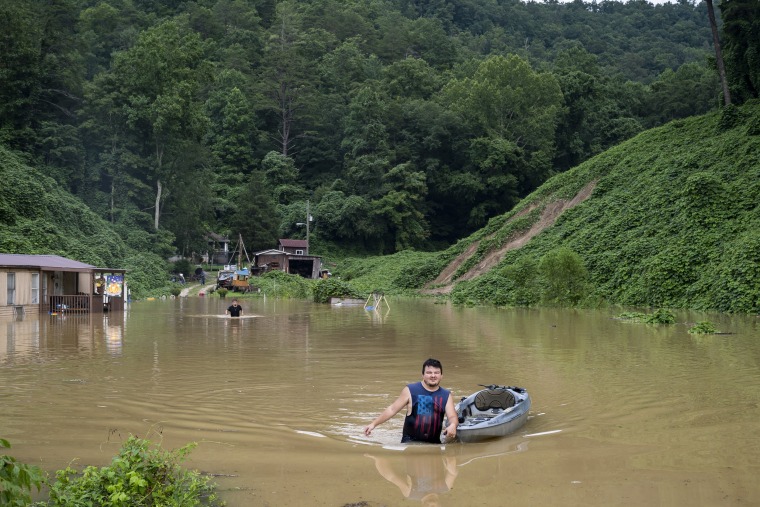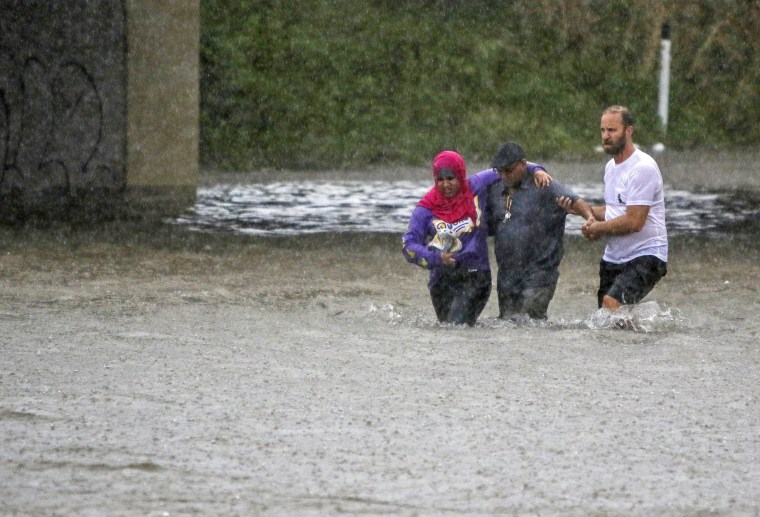Dallas has joined four other U.S. communities that have recently experienced hot — and then suddenly much too wet — summers.
Extreme rainfall hammered the Dallas area Monday, killing at least one person, requiring hundreds of rescues and adding the city to a list of communities in the nation that saw precipitation so intense that it was expected just once in a millennium.
Some parts of Dallas saw more than 13 inches of precipitation in 12 hours, according to the city’s water utility — enough to exceed the marker set by the National Oceanic and Atmospheric Administration for a 1-in-1,000-year precipitation event.
Elsewhere, heavy rainfall left 37 people dead in eastern Kentucky, closed all roadways in the Death Valley National Park near the California-Nevada border, forced rescues in suburban St. Louis and sent vehicles into ditches in southern Illinois. Each of these storms has been described as a 1-in-1,000-year event, meaning that each year, there is a .1% chance it could happen, based on historical data.
But climate researchers say a warmer atmosphere has juiced the potential for extreme rainfall and damaging flooding. Although it’s difficult for scientists to immediately interpret the link between a single weather event — or string of events — and climate change, human-caused warming has rapidly shifted the probability of extremes so much that some of them say these numbers are losing their relevance as benchmarks because they’re changing so fast.
“It’s very concerning, this whole concept of return period — the 1-in- 1,000-year storm — doesn’t really hold up anymore. The climate has changed,” said Andreas Prein, a research scientist at the National Center for Atmospheric Research in Boulder, Colorado.

The rainfall in Dallas nearly set the city’s all-time record for 24-hour rainfall, with 9.19 inches of rain recorded at Dallas-Fort Worth International Airport, according to the National Weather Service. It was the second-most rain recorded during a 24-hour period in any season or year. Mean precipitation for the airport in August is about 2.18 inches.
Rainfall totals throughout the metropolitan area were uneven, according to Jennifer Dunn, a Fort-Worth based meteorologist with the weather service.
A rain gauge near a creek in east Dallas measured more than 15 inches of rain during the rainstorm, she said. Over the same time period and 25 miles north, “they didn’t get an inch of rain.”
Hard-hit areas saw flash flooding, particularly on roadways and concrete infrastructure not designed for such intense precipitation, Dunn said.
Before Monday, northern Texas remained mired in exceptional drought, according to the U.S. drought monitor.
“We have seen some very high rainfall totals that definitely are helping to alleviate some of the ongoing drought conditions,” Dunn said. “In some areas, it’s not going to be enough to erase the deficits.”
Each region of the U.S. has its own recipe for heavy rain, Prein said. Along the West Coast, atmospheric river storms, which draw moisture from the tropical Pacific, provide deluges. In the Midwest, mesoscale convective systems (a collection of thunderstorms that operate as a system) are responsible for the most intense rains.
For Dallas on Monday, two sources of moisture from the Gulf of Mexico and the Pacific Ocean combined with a slow-moving front to produce the inundating rains.

“No matter where you are, you see the same changes. We have higher rainfall intensities now than 50 years ago,” Prein said, adding that it’s a trend observed in both weather observations and climate modeling.
There are several reasons for the trend.
Chief among them: A warmer atmosphere can simply hold more moisture. “We’ve known this for almost 200 years from physics,” Prein said.
For every degree Fahrenheit of warming, the atmosphere can absorb about 4.5% more water, Prein said. For every degree Celsius, that figure is about 7%. Human activities have been responsible for about 1.1 degrees Celsius of global warming so far, according to a recent United Nations report on climate change.
In the right conditions, “you can wring more moisture out of the atmosphere” today than in the past, he said. That’s a trend that will continue to amplify as the world grows warmer, a result of humanity’s reliance on oil and gas.
Some research suggests climate change is also causing storms to grow.
“The storms themselves are changing as well. We have a few studies showing the storms that increase heavy rainfall are increasing in size,” Prein said.
In the future, researchers expect more intense droughts, punctuated by severe bursts of precipitation.
“The variability of rainfall is increasing,” Prein said. “We expect that there are longer periods that are dry and short periods that are very wet.”
Of the five regions that saw 1-in-1,000-year rainfall this summer, four had been experiencing droughts of varying intensities.
These trends have made a mess of the probabilities meteorologists, engineers and average people use to contextualize the likelihood of flooding or exceptional rainfall. As the climate warms, risks shift.
“What does a 1-in-1,000-year event mean?” said Robert Jnglin Wills, a research scientist in the department of atmospheric sciences at the University of Washington. “That can be calculated in the climate of the past or the distant past before greenhouse gases were affecting the climate at all. This is changing continuously with climate change.”
As the world warms, the likelihood of what was once a 1-in-1,000-year event has shifted dramatically.
Just considering the increase in warming since the early 20th century and through today, “the probability of an event like this has increased by a factor of between 1.5 and 5,” Wills said, citing data from several studies, whose results vary by region, season and other factors.

Added Prein: “What was once a 1-in-1,000-year storm 30 years ago is now maybe a once-in-500-year storm.”
These shifting benchmarks have important implications for infrastructure and how the public perceives risk.
“If you want to build a dam or a highway or a hospital, it’s difficult to build your infrastructure in a way that you ensure it will not get flooded. The risk is changing so quickly,” Prein said. “We are seeing our infrastructure doesn’t hold up. Making our cities more flood resilient is really important.”
The world is on pace for global average temperatures to rise roughly 3.2 degrees Celsius (5.8 degrees Fahrenheit) by the end of the century, in comparison to preindustrial times.
“If we can limit warming to 2 degrees Celsius in the Paris Agreement, this would help mitigate extreme consequences,” Prein said.